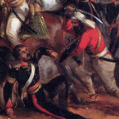-
Topics
-
Posts
-
Found how to do it. For anybody else wondering, heres how. No one even helped me btw. So much for Guru Ji’s lhalsa always ready to help (and having their Singhs’ backs smh). (Notes: Aim to do this on a hot summer’s day, and dedicate a full day to this, since you only have to do this once every 4 months at least (normally the turban will stay in shape until you wish to untie it and physically pull it open again). This helps it to dry faster, since you have to starch it, HALF DRY IT, pooni it, tie it and then wear it for around four hours for the rest of it to dry, all in the same day. It’s a one day process but it serves you for months). This works for both the UK/Kenyan style (starch is best for this style) as well as the normal Punjabi paghs (such as Patiala shahi, wattan wali and morni paghs). Not sure about dumallas though. Probably not . Pagg Starch: 1) Boil 6 cups of water in a saucepan on low heat (always low heat) 2) Seperately dissolve 4 tablespoons of maida (all purpose flower) with a little water until it is 100% smooth. You could also use rice or corn starch. Add more water if it is not a smooth liquid 3) Once completely smooth, pour this mixture through a strainer (to make it even smoother) into the boiling water. 4) Now continuously stir it until it goes completely see through. Keep on stirring it on the low heat until it goes totally transparent (it can take a little while to cook, but the pagg will last you for months!) It will at become a thick paste first, but keep stirring until it becomes see through and thinner. 5) Once it’s transparent, pour the starch (again through a strainer) into a big enough, clean bucket to cool down. 6) Once cool, take a clean, dry turban and completely and mix it in with the starch for around 5 minutes. Make sure that it is all evenly and completely soaked and wet with the starch. (Most people use mal-mal material, but I use full voile and I have used Rubia too. They’re all fine. Maybe use Rubin for smaller turbans and mal mal for larger ones) 7) Leave it out in the sun to HALF DRY ONLY!!!!!!! (Don’t ever let your starched turban fully dry before you tie it. If you do, then you will have to spray/ sprinkle water on it which will weaken the starch and ruin the turban) ONLY HALF DRY THE TURBAN IN THE SUN!!! 😎 Once HALF DRY ONLY take the now semi damp turban, and fold/pooni and then tie it like normal (straight on your head, with no base layer such as a Keski or patka underneath). Leave it on your head for around 4 hours just to fully dry and it will be ready and set for months now. Like I said, do try to tie your dastar every day, but if you can’t or really don’t want to, I hope this helps! Like I said this works on both the traditional Punjabi/Indian style paggs, and the more recent UK/Kenyan style paggs. It does for my morni pagg, but the first larr slips up in to the pagg. This is normal dw. Wjkk, Wjkf
-
I guess easier ways of learning have taken precedence. There are so many Youtube channels and podcasts available that people are more ready to listen for knowledge at their own leisure. There are so many great kathas available online that take months to listen, so that people may not really get the time to come here and write.
-
*Bump The current conflict (w/ Iran getting involved) is being orchestrated by a 3rd party in my opinion. We all are going to blame the Jewish community (how they run the banks, how they are brutal and etc.) but they have a point in this conflict. As soon as people start finding about the truth that's when the real movement will begin.
-
By MokhamSingh · Posted
https://www.youtube.com/live/FcXcuvkIT9I?si=qzOSWY7EEOXDaNv2 -
By ChardikalaUK · Posted
Might delay Sikhs becoming a minority in Punjab for a few more years. Do these students actually study and work in a related field after their course or is it purely for immigration?
-






Recommended Posts
Join the conversation
You can post now and register later. If you have an account, sign in now to post with your account.